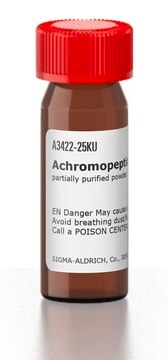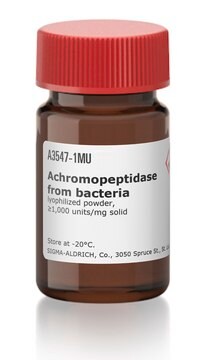A3611
Arachidonic acid
from non-animal source, ≥98.5% (GC)
Sinonimo/i:
cis,cis,cis,cis-5,8,11,14-Eicosatetraenoic acid, Eicosa-5Z,8Z,11Z,14Z-tetraenoic acid, Immunocytophyte
About This Item
Prodotti consigliati
Origine biologica
non-animal source
Livello qualitativo
Saggio
≥98.5% (GC)
Stato
liquid
Indice di rifrazione
n20/D 1.4872 (lit.)
P. ebollizione
169-171 °C/0.15 mmHg (lit.)
Punto di fusione
−49 °C (lit.)
Densità
0.922 g/mL at 25 °C (lit.)
Gruppo funzionale
carboxylic acid
Tipo di lipide
omega FAs
Condizioni di spedizione
dry ice
Temperatura di conservazione
−20°C
Stringa SMILE
OC(CCC/C=C\C/C=C\C/C=C\C/C=C\CCCCC)=O
InChI
1S/C20H32O2/c1-2-3-4-5-6-7-8-9-10-11-12-13-14-15-16-17-18-19-20(21)22/h6-7,9-10,12-13,15-16H,2-5,8,11,14,17-19H2,1H3,(H,21,22)/b7-6-,10-9-,13-12-,16-15-
YZXBAPSDXZZRGB-DOFZRALJSA-N
Cerchi prodotti simili? Visita Guida al confronto tra prodotti
Applicazioni
<li><strong>Molecular Mechanisms Associated with the Inhibitory Role of Long Chain n-3 PUFA in Colorectal Cancer:</strong> This study discusses the effects of long-chain polyunsaturated fatty acids, like arachidonic acid, on colorectal cancer mechanisms. The research focuses on the anti-inflammatory and cancer inhibitory roles through the modulation of lipid metabolism and signal transduction pathways (Jayathilake et al., 2024).</li>
<li><strong>Zhilining Formula alleviates DSS-induced colitis through suppressing inflammation and gut barrier dysfunction via the AHR/NF-Bp65 axis:</strong> This article presents arachidonic acid′s role in the suppression of inflammation and restoration of gut barrier function, crucial for understanding inflammatory diseases and developing therapeutic strategies (Zhou et al., 2024).</li>
<li><strong>5,6-diHETE lactone (EPA-L) mediates hypertensive microvascular dilation by activating the endothelial GPR-PLC-IP(3) signaling pathway:</strong> Explores the cardiovascular implications of arachidonic acid metabolites, specifically their role in microvascular responses, which could influence hypertension treatment strategies (Asulin et al., 2024).</li>
</ul>
Azioni biochim/fisiol
Confezionamento
Avvertenze
Warning
Indicazioni di pericolo
Consigli di prudenza
Classi di pericolo
Eye Irrit. 2 - Skin Irrit. 2
Codice della classe di stoccaggio
10 - Combustible liquids
Classe di pericolosità dell'acqua (WGK)
WGK 3
Punto d’infiammabilità (°F)
235.4 °F - closed cup
Punto d’infiammabilità (°C)
113 °C - closed cup
Scegli una delle versioni più recenti:
Certificati d'analisi (COA)
Non trovi la versione di tuo interesse?
Se hai bisogno di una versione specifica, puoi cercare il certificato tramite il numero di lotto.
Possiedi già questo prodotto?
I documenti relativi ai prodotti acquistati recentemente sono disponibili nell’Archivio dei documenti.
I clienti hanno visto anche
Il team dei nostri ricercatori vanta grande esperienza in tutte le aree della ricerca quali Life Science, scienza dei materiali, sintesi chimica, cromatografia, discipline analitiche, ecc..
Contatta l'Assistenza Tecnica.










